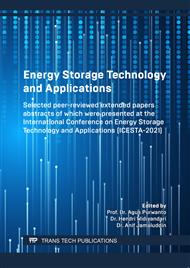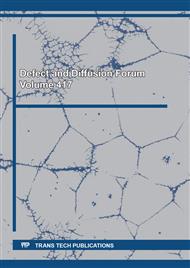[1]
S.A. Firnadya, A.Z. Syahrial, A. Subhan, Enhancing battery performance by nano Si addition to Li4Ti5O12 as anode material on lithium-ion battery, Ionics (Kiel). 24 (2018) 1029–1037.
DOI: 10.1007/s11581-017-2284-6
Google Scholar
[2]
B. Zhao, R. Ran, M. Liu, Z. Shao, A comprehensive review of Li4Ti5O12-based electrodes for lithium-ion batteries: The latest advancements and future perspectives, Mater. Sci. Eng. R Reports. 98 (2015) 1–71.
DOI: 10.1016/j.mser.2015.10.001
Google Scholar
[3]
A. Mahmoudzadeh Andwari, A. Pesiridis, S. Rajoo, R. Martinez-Botas, V. Esfahanian, A review of Battery Electric Vehicle technology and readiness levels, Renew. Sustain. Energy Rev. 78 (2017) 414–430.
DOI: 10.1016/j.rser.2017.03.138
Google Scholar
[4]
N. Nitta, F. Wu, J.T. Lee, G. Yushin, Li-ion battery materials: Present and future, Mater. Today. 18 (2015) 252–264.
DOI: 10.1016/j.mattod.2014.10.040
Google Scholar
[5]
D.A.H. Hanaor, C.C. Sorrell, Review of the anatase to rutile phase transformation, J. Mater. Sci. 46 (2011) 855–874.
DOI: 10.1007/s10853-010-5113-0
Google Scholar
[6]
H. Liu, G. Wen, S. Bi, P. Gao, Enhanced rate performance of nanosized Li4Ti5O12/graphene composites as anode material by a solid state-assembly method, Electrochim. Acta. 171 (2015) 114–120.
DOI: 10.1016/j.electacta.2015.05.008
Google Scholar
[7]
P.W. Winowatan, S. Selwyn, B. Priyono, A.Z. Syahrial, Enhancing battery performance of Li4Ti5O12 nanorod synthesized by hydrothermal method with Sn addition as anode material for lithium-ion battery, J. King Saud Univ. - Eng. Sci. 33 (2021) 396–403.
DOI: 10.1016/j.jksues.2020.05.009
Google Scholar
[8]
A. Wei, W. Li, L. Zhang, B. Ren, X. Bai, Z. Liu, Enhanced electrochemical performance of a LTO/N-doped graphene composite as an anode material for Li-ion batteries, Solid State Ionics. 311 (2017) 98–104.
DOI: 10.1016/j.ssi.2017.09.017
Google Scholar
[9]
C. Zhang, Y. Zhang, J. Wang, D. Wang, D. He, Y. Xia, Li4Ti5O12 prepared by a modified citric acid solegel method for lithium-ion battery, J. Power Source. 236 (2013) 118–125.
DOI: 10.1016/j.jpowsour.2013.01.135
Google Scholar
[10]
X. Guo, Q. Zhang, X. Ding, Q. Shen, C. Wu, L. Zhang, H. Yang, Synthesis and application of several sol–gel-derived materials via sol–gel process combining with other technologies: a review, J. Sol-Gel Sci. Technol. 79 (2016) 328–358.
DOI: 10.1007/s10971-015-3935-6
Google Scholar
[11]
Y.M. Liza, R.C. Yasin, S.S. Maidani, R. Zainul, Gelation Sol- Gel Proces s Densification Ageing Drying, Pendidik. FMIPA Univ. Negeri Padang. (2018).
Google Scholar
[12]
A.Z. Syahrial, B. Priyono, A.H. Yuwono, E. Kartini, H. Jodi, Johansyah, Synthesis of lithium titanate (Li4Ti5O12) by addition of excess lithium carbonate (Li2CO3) in titanium dioxide (TiO2) xerogel, Int. J. Technol. 7 (2016) 392–400.
DOI: 10.14716/ijtech.v7i3.2890
Google Scholar
[13]
H.C. Lee, W.-W. Liu, S.-P. Chai, A.R. Mohamed, C.W. Lai, C.-S. Khe, C.H. Voon, U. Hashim, N.M.S. Hidayah, Synthesis of Single-layer Graphene: A Review of Recent Development, Procedia Chem. 19 (2016) 916–921.
DOI: 10.1016/j.proche.2016.03.135
Google Scholar
[14]
Y. Shi, J. Gao, H.D. Abruña, H. Liu, H. Li, J. Wang, Y. Wu, Rapid synthesis of Li4Ti5O12/graphene composite with superior rate capability by a microwave-assisted hydrothermal method, Nano Energy. 8 (2014) 297–304.
DOI: 10.1016/j.nanoen.2014.06.009
Google Scholar
[15]
Z. He, Z. Wang, F. Wu, H. Guo, X. Li, X. Xiong, Spherical Li 4Ti 5O 12 synthesized by spray drying from a different kind of solution, J. Alloys Compd. 540 (2012) 39–45.
DOI: 10.1016/j.jallcom.2012.06.044
Google Scholar
[16]
D. Yoshikawaa, Y. Kadomaa, J.-M. Kima, K. Uia, N. Kumagaia, N. Kitamurab, Y. Idemoto, property as negative electrode material for Li-ion batteries Spray-drying synthesized lithium-excess Li4+xTi5−xO12−ı and its electrochemical, Electrochim. Acta. 55 (2010) 1872–1879.
DOI: 10.1016/j.electacta.2009.10.082
Google Scholar
[17]
J.Y. Eom, Y.H. Cho, S.I. Kim, D. Han, D. Sohn, Improvements in the electrochemical performance of Li4Ti5O12-coated graphite anode materials for lithium-ion batteries by simple ball-milling, J. Alloys Compd. 723 (2017) 456–461.
DOI: 10.1016/j.jallcom.2017.06.210
Google Scholar
[18]
T.M. Zima, A. V. Kozlova, N.F. Uvarov, Hydrothermal treatment of layered sodium titanate nanostructures and their conversion to Li4Ti5O12, Mater. Today Proc. 31 (2020) 522–525.
DOI: 10.1016/j.matpr.2020.06.085
Google Scholar
[19]
J.S. Park, C.L. Margez, T.A. Greszler, Effect of Particle Size and Electronic Percolation on Low-Temperature Performance in Lithium Titanate-Based Batteries, ACS Omega. 4 (2019) 21048–21053.
DOI: 10.1021/acsomega.9b02393
Google Scholar
[20]
E. Pohjalainen, T. Rauhala, M. Valkeapää, J. Kallioinen, T. Kallio, Effect of Li4Ti5O12 particle size on the performance of lithium ion battery electrodes at high C-rates and low temperatures, J. Phys. Chem. C. 119 (2015) 2277–2283.
DOI: 10.1021/jp509428c
Google Scholar
[21]
J. Li, Shaojie; Mao, S. Li, J. Mao, The Influence of Different Types of Graphene on the Lithium Titanate Anode Materials of a Lithium Ion Battery.pdf, J. Electron. Mater. 47 (2018) 5410–5416.
DOI: 10.1007/s11664-018-6439-7
Google Scholar
[22]
Y. Shi, L. Wen, F. Li, H.M. Cheng, Nanosized Li4Ti5O12/graphene hybrid materials with low polarization for high rate lithium ion batteries, J. Power Sources. 196 (2011) 8610–8617.
DOI: 10.1016/j.jpowsour.2011.06.002
Google Scholar
[23]
M. Wall, The Raman Spectroscopy of Graphene and the Determination of Layer Thickness, Thermo Sci. (2011) 5.
Google Scholar
[24]
A. Subhan, F. Oemry, S.N. Khusna, E. Hastuti, Effects of activated carbon treatment on Li 4 Ti 5 O 12 anode material synthesis for lithium-ion batteries, Ionics (Kiel). 25 (2019) 1025–1034.
DOI: 10.1007/s11581-018-2633-0
Google Scholar
[25]
T. Kim, W. Choi, H.C. Shin, J.Y. Choi, J.M. Kim, M.S. Park, W.S. Yoon, Applications of voltammetry in lithium ion battery research, J. Electrochem. Sci. Technol. 11 (2020) 14–25.
DOI: 10.33961/jecst.2019.00619
Google Scholar
[26]
E. Simamora, J. Riady, B. Priyono, A.Z. Syahrial, Effect of Carbon Active Addition to Electrochemical Performance of Li4Ti5O12/SnO2 Composite Anode on Lithiumion Battery, J. Phys. Conf. Ser. 1494 (2020).
DOI: 10.1088/1742-6596/1494/1/012045
Google Scholar
[27]
Y. Hui, L. Cao, Z. Xu, J. Huang, H. Ouyang, J. Li, Mesoporous Li4Ti5O12 nanoparticles synthesized by a microwave-assisted hydrothermal method for high rate lithium-ion batteries, J. Electroanal. Chem. 763 (2016) 45–50.
DOI: 10.1016/j.jelechem.2015.12.042
Google Scholar
[28]
H. Yan, W. Yao, R. Fan, Y. Zhang, J. Luo, J. Xu, Mesoporous Hierarchical Structure of Li4Ti5O12/Graphene with High Electrochemical Performance in Lithium-Ion Batteries, ACS Sustain. Chem. Eng. 6 (2018) 11360–11366.
DOI: 10.1021/acssuschemeng.8b01211
Google Scholar
[29]
D. Sui, L. Si, C. Li, Y. Yang, Y. Zhang, W. Yan, A Comprehensive Review of Graphene-Based Anode Materials for Lithium-ion Capacitors, Chemistry (Easton). 3 (2021) 1215–1246.
DOI: 10.3390/chemistry3040089
Google Scholar
[30]
A.K. Rai, J. Gim, S.W. Kang, V. Mathew, L.T. Anh, J. Kang, J. Song, B.J. Paul, J. Kim, Improved electrochemical performance of Li 4Ti 5O 12 with a variable amount of graphene as a conductive agent for rechargeable lithium-ion batteries by solvothermal method, Mater. Chem. Phys. 136 (2012) 1044–1051.
DOI: 10.1016/j.matchemphys.2012.08.048
Google Scholar
[31]
C. Lu, X. Wang, X. Zhang, H. Peng, Y. Zhang, G. Wang, Z. Wang, G. Cao, N. Umirov, Z. Bakenov, Effect of graphene nanosheets on electrochemical performance of Li4Ti5O12 in lithium-ion capacitors, Ceram. Int. 43 (2017) 6554–6562.
DOI: 10.1016/j.ceramint.2017.02.083
Google Scholar
[32]
H.-H. Chang, T.-H. Ho, Y.-S. Su, Graphene-Enhanced Battery Components in Rechargeable Lithium-Ion and Lithium Metal Batteries, C. 7 (2021) 65.
DOI: 10.3390/c7030065
Google Scholar



